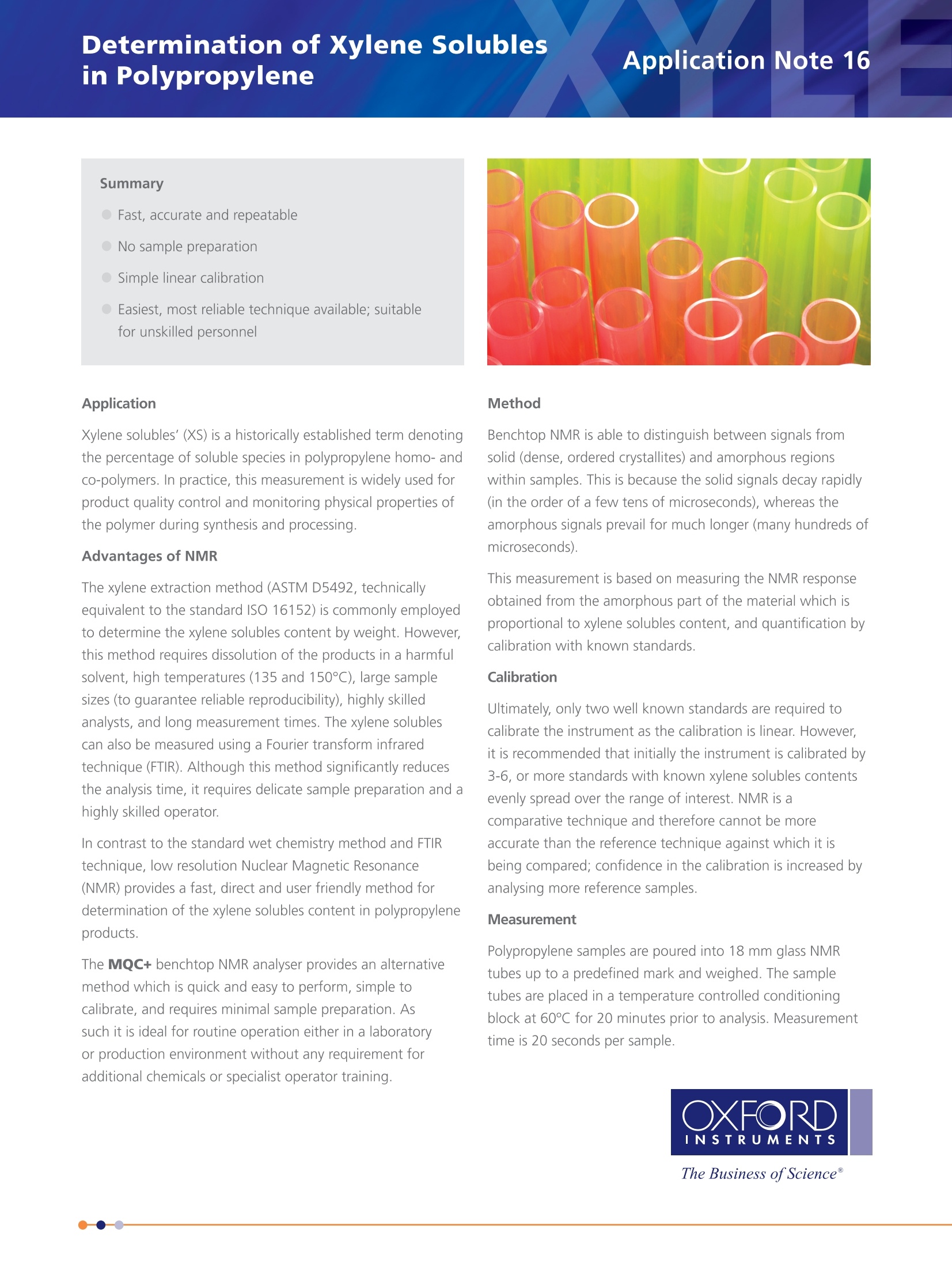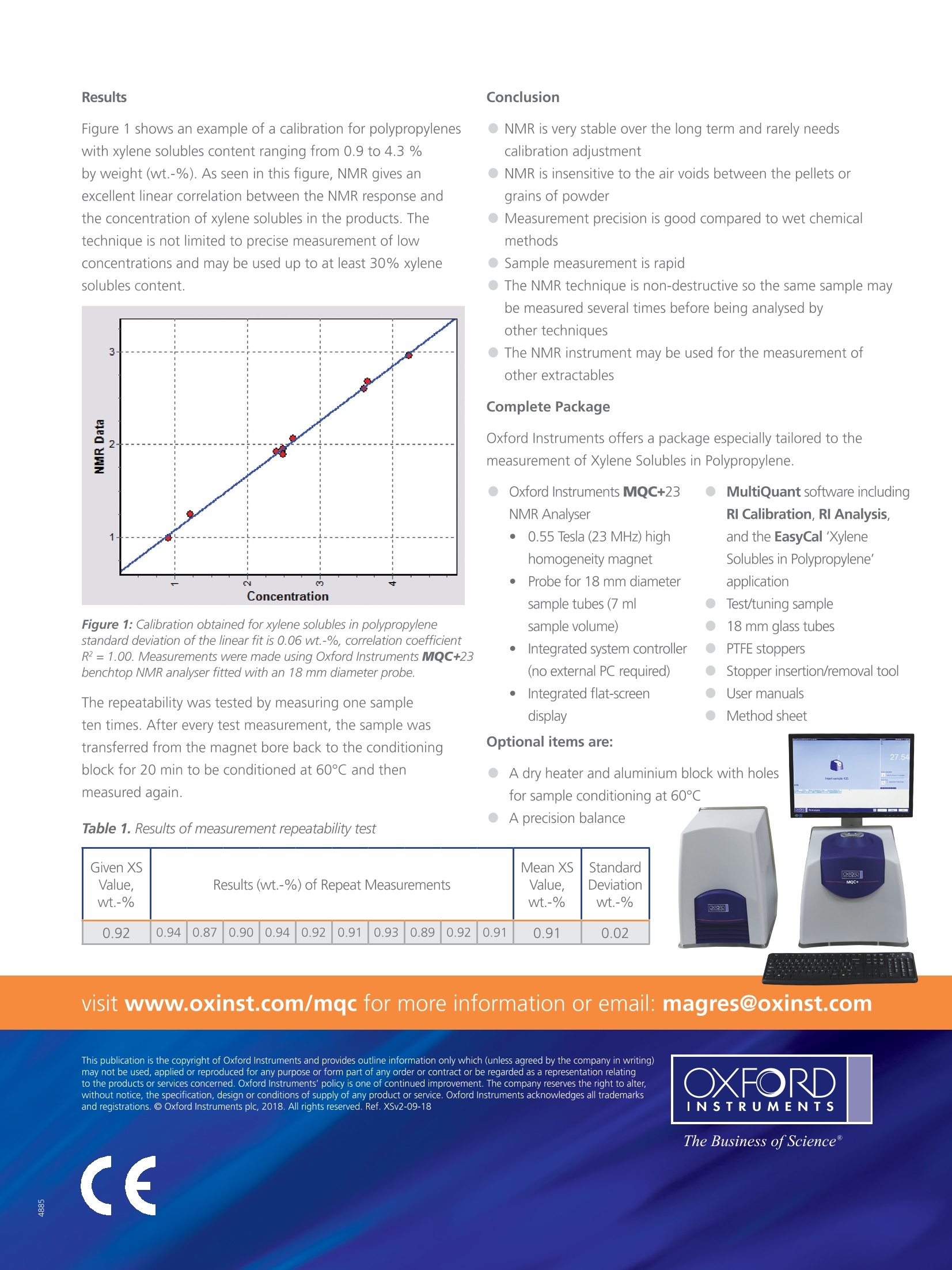方案详情
文
聚合物生产过程中,测定聚丙烯中的二甲苯可溶物含量是一项标准且重要的质量控制措施。当今工业中,聚丙烯是一种最常见的聚合物。该材料具有极其广泛的应用,拥有多种不同生产配方和等级,工厂根据最终用途对其性能进行相应优化。
方案详情

Application Note 16 Results Application Xylene solubles'(XS) is a historically established term denotingthe percentage of soluble species in polypropylene homo- andco-polymers. In practice, this measurement is widely used forproduct quality control and monitoring physical properties ofthe polymer during synthesis and processing. Advantages of NMR The xylene extraction method (ASTM D5492, technicallyequivalent to the standard ISO 16152) is commonly employedto determine the xylene solubles content by weight. However,this method requires dissolution of the products in a harmfulsolvent, high temperatures (135 and 150℃), large samplesizes (to guarantee reliable reproducibility), highly skilledanalysts, and long measurement times. The xylene solublescan also be measured using a Fourier transform infraredtechnique (FTIR). Although this method significantly reducesthe analysis time, it requires delicate sample preparation and ahighly skilled operator. In contrast to the standard wet chemistry method and FTIRtechnique, low resolution Nuclear Magnetic Resonance(NMR) provides a fast, direct and user friendly method fordetermination of the xylene solubles content in polypropyleneproducts. The MQC+ benchtop NMR analyser provides an alternativemethod which is quick and easy to perform, simple tocalibrate, and requires minimal sample preparation. Assuch it is ideal for routine operation either in a laboratoryor production environment without any requirement foradditional chemicals or specialist operator training. Method Benchtop NMR is able to distinguish between signals fromsolid (dense, ordered crystallites) and amorphous regionswithin samples. This is because the solid signals decay rapidly(in the order of a few tens of microseconds), whereas theamorphous signals prevail for much longer (many hundreds ofmicroseconds). This measurement is based on measuring the NMR responseobtained from the amorphous part of the material which isproportional to xylene solubles content, and quantification bycalibration with known standards. Calibration Ultimately, only two well known standards are required tocalibrate the instrument as the calibration is linear.Howeverit is recommended that initially the instrument is calibrated by3-6, or more standards with known xylene solubles contentsevenly spread over the range of interest. NMR is acomparative technique and therefore cannot be moreaccurate than the reference technique against which it isbeing compared; confidence in the calibration is increased byanalysing more reference samples. Measurement Polypropylene samples are poured into 18 mm glass NMRtubes up to a predefined mark and weighed. The sampletubes are placed in a temperature controlled conditioningblock at 60℃ for 20 minutes prior to analysis. Measurementtime is 20 seconds per sample. Figure 1 shows an example of a calibration for polypropyleneswith xylene solubles content ranging from 0.9 to 4.3 %by weight (wt.-%). As seen in this figure, NMR gives anexcellent linear correlation between the NMR response andthe concentration of xylene solubles in the products. Thetechnique is not limited to precise measurement of lowconcentrations and may be used up to at least 30% xylenesolubles content. Figure 1: Calibration obtained for xylene solubles in polypropylenestandard deviation of the linear fit is 0.06 wt.-%, correlation coefficientR²=1.00. Measurements were made using Oxford Instruments MQC+23benchtop NMR analyser fitted with an 18 mm diameter probe. The repeatability was tested by measuring one sampleten times. After every test measurement, the sample wastransferred from the magnet bore back to the conditioningblock for 20 min to be conditioned at 60°C and thenmeasured again. Table 1. Results of measurement repeatability test ● NMR is very stable over the long term and rarely needscalibration adjustment ● NMR is insensitive to the air voids between the pellets orgrains of powder ● Measurement precision is good compared to wet chemicalmethods ● SSaample measurement is rapid ● The NMR technique is non-destructive so the same sample maybe measured several times before being analysed byother techniques ●TThe NMR instrument may be used for the measurement ofother extractables Complete Package Oxford Instruments offers a package especially tailored to themeasurement of Xylene Solubles in Polypropylene. ●Oxford Instruments MQC+23NMR Analyser ● ·0.55 Tesla (23 MHz) highhomogeneity magnet MultiQuant software includingRI Calibration, RI Analysis,and the EasyCal 'XyleneSolubles in Polypropylene' Probe for 18 mm diametersample tubes (7 mlsample volume) application Test/tuning sample 18 mm glass tubes Integrated system controller(no external PC required) ●PTFE stoppers Stopper insertion/removal tool ·IIntegrated flat-screenUser manualsdisplayMethod sheet Optional items are: ●A dry heater and aluminium block with holesfor sample conditioning at 60℃ ●A precision balance Given XSValue,wt.-% Results (wt.-%) of Repeat Measurements Mean XSValue,wt.-% StandardDeviationwt.-% 0.92 0.94 0.87 0.90 0.94 0.92 0.91 0.93 0.89 0.92 0.91 0.91 0.02 visit www.oxinst.com/mqc for more information or email: magres@oxinst.com 聚合物生产过程中,测定聚丙烯中的二甲苯可溶物含量是一项标准且重要的质量控制措施。当今工业中,聚丙烯是一种最常见的聚合物。该材料具有极其广泛的应用,拥有多种不同生产配方和等级,工厂根据最终用途对其性能进行相应优化。
确定


还剩1页未读,是否继续阅读?
牛津仪器科技(上海)有限公司为您提供《聚丙烯中二甲苯可溶物检测方案(核磁共振)》,该方案主要用于其他中二甲苯可溶物检测,参考标准--,《聚丙烯中二甲苯可溶物检测方案(核磁共振)》用到的仪器有牛津仪器MQC+台式磁共振分析仪
相关方案
更多
该厂商其他方案
更多










